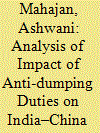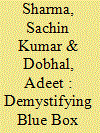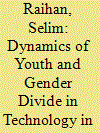|
|
|
Sort Order |
|
|
|
Items / Page
|
|
|
|
|
|
|
| Srl | Item |
| 1 |
ID:
180248


|
|
|
|
|
| Summary/Abstract |
India has imposed anti-dumping duties (ADDs) on a total of 155 commodities against China across many sectors to protect the domestic industry since 2001. The dumping of Chinese goods into Indian markets has led to the downfall and closure of many domestic industries. Under such circumstances, ADDs had been necessitated for protecting the domestic industry. As per the World Trade Organization (WTO) rules, imposition of ADDs on imports is permitted, provided that the affected country establishes that the domestic industry has suffered material injury by such imports. An elaborate discussion explaining the investigation pertaining to ADD and imposition of ADD in relation with WTO rules is presented in the present article. During the period between 2014 and 2018, ADD has been imposed on a total of 121 commodities. The study finds that ADDs have been partially effective in reducing the imports of the commodities.
|
|
|
|
|
|
|
|
|
|
|
|
|
|
|
|
| 2 |
ID:
180245


|
|
|
|
|
| Summary/Abstract |
Developing members at the WTO face a shrinkage in policy space for supporting their agricultural sector due to the limited room available under the provisions of the Agreement on Agriculture (AoA). Contrastingly, most developed members can provide high levels of product-specific support without breaching their commitments on account of their support entitlements. For some of these members, the so-called ‘Blue Box’ under the AoA, plays a pivotal role in expanding the policy space with respect to domestic support to agricultural products. Though a lot of scholarship has discussed and examined other support provisions under the AoA, the ‘Blue Box’ remains relatively shrouded in mystery. Testimony to this is the fact that although the Blue Box has found use amongst developed members, no developing member, except for China in 2016, has ever used the Blue Box to support their producers. Given the impasse in the Doha Round of negotiations and limited flexibilities available under the AoA, this paper examines the feasibility and compatibility Blue Box measures with developing members’ socio-economic situation. Findings of this paper bring to fore the variations in member practice and the operational flexibilities available in implementing Blue Box programmes to support agriculture.
|
|
|
|
|
|
|
|
|
|
|
|
|
|
|
|
| 3 |
ID:
180247


|
|
|
|
|
| Summary/Abstract |
This article identifies the nature of gendered digital divides between male and female youth (aged 15–29) in the context of Bangladesh. As a measuring indicator for technology inclusiveness, this study examines whether a young male or female owns a mobile phone, the most basic means of accessing the Internet. As observed in the descriptive analysis, on average, 46% of young females have a mobile phone, compared to 79% young males. However, such disparity varies across age cohorts and the divides of rural–urban, poor–non-poor, richer–poorer income deciles, etc. To understand whether there is any significant discrimination against women in terms of technology inclusiveness, this study applies the Blinder–Oaxaca (B–O) decomposition technique. The decomposition analysis shows statistically significant discrimination against women in terms of mobile ownership at both the household and the individual level. The factors such as remittances, average years of schooling of the household members, urban residence, household’s income status, etc., significantly reduce discriminatory behaviour towards young females.
|
|
|
|
|
|
|
|
|
|
|
|
|
|
|
|
| 4 |
ID:
180246


|
|
|
|
|
| Summary/Abstract |
This study endeavours to augment the existing literature on the productive efficiency of Indian domestic banks in the presence of non-performing assets (NPAs), by employing the Weighted Russell Directional Distance Model (WRDDM). Following the intermediation approach, the banking technology set includes three inputs, three desirable outputs and one undesirable output, namely NPAs. Due to their inherent technological heterogeneity, public sector banks (PSBs) and private banks (PVBs) have been analysed as separate groups. Balanced panels of 26 PSBs and 18 PVBs are constructed from 2010-2011 to 2016-2017. The results indicate a considerable scope of improvement in the productive performance of both categories of banks. The break-up of overall inefficiency into input- and output-specific components reveals some stimulating information. For PSBs, the inefficiencies primarily result due to physical capital, while for PVBs they emerge mainly from other incomes. However, NPAs are also a key contributor to inefficiency for both the categories of banks. The inefficiency scores also indicate that, across ownership categories, medium-sized banks are poorer performers than their smaller and larger counterparts.
|
|
|
|
|
|
|
|
|
|
|
|
|
|
|
|
|
|
|
|
|